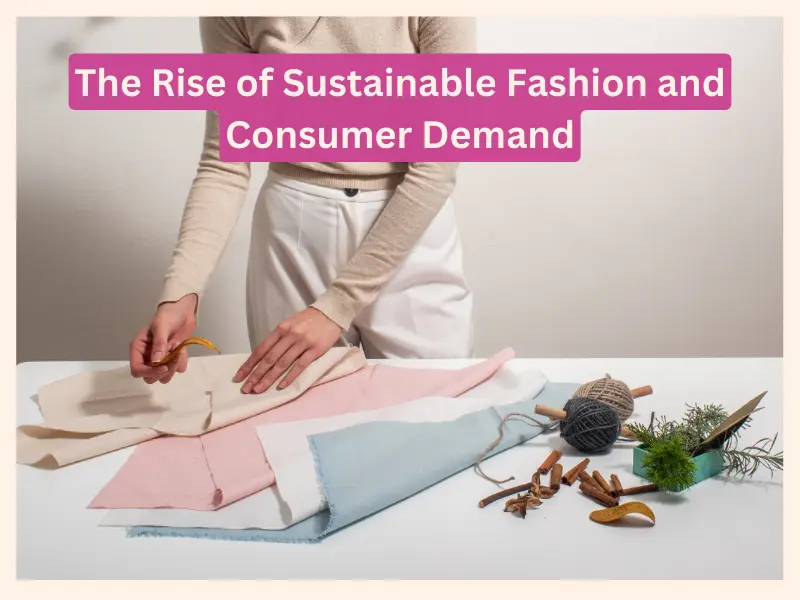The fashion industry has long been a trendsetter, but unfortunately, its reign has come at a significant environmental cost. Fast fashion, characterized by mass-produced, low-cost, and often disposable clothing, has become a major polluter.
These staggering numbers highlight the urgent need for a more sustainable approach to clothing.

The good news? The future of fashion is bright – and sustainable! A growing number of brands and consumers are embracing eco-friendly practices, and you can be a part of this positive change too.
Building a sustainable brand doesn’t mean sacrificing style; it’s about promoting conscious choices that benefit both closets and the planet.
The Dark Side of Fast Fashion: Why Sustainability Matters
Before diving into building your eco-friendly brand, let’s delve deeper into the environmental impact of fast fashion:
- Pollution: The fashion industry is the second-largest polluter of clean water globally. Textile dyeing releases harmful chemicals into waterways, while synthetic fabrics like polyester shed microplastics that pollute oceans.
- Waste: A staggering statistic from the Ellen MacArthur Foundation report estimates that a garbage truck full of textiles is landfilled or incinerated every single second. Fast fashion encourages a disposable clothing culture, leading to mountains of textile waste.
- Water Consumption: Cotton production is notoriously water-intensive, requiring vast amounts of water to grow and process. By using sustainable alternatives like organic cotton or recycled materials, pesticides can be significantly reduced..
Beyond environmental concerns, fast fashion often falls short on ethical labor practices. Low garment prices often translate to low wages for factory workers, particularly in developing countries.
Consumers are becoming increasingly aware of these issues, and the demand for sustainable and ethically produced fashion is rapidly growing.
This presents a unique opportunity for fashion brands. By embracing sustainability, brands can not only reduce their environmental footprint but also tap into a lucrative market.
The Rise of Sustainable Fashion and Consumer Demand
Consumers are becoming increasingly concerned about the environmental impact of the fashion industry. A 2021 Global Fashion Survey by McKinsey & Company found that 70% of consumers are now willing to pay a premium for sustainable clothing. This shift in consumer behavior presents a significant opportunity for brands that prioritize sustainability.

Benefits of Sustainable Fashion for Brands
- Increased Brand Loyalty: Consumers are actively seeking out sustainable brands. By aligning your brand with eco-conscious values, you can attract a loyal customer base willing to support your mission.
- Enhanced Brand Image: Sustainability is no longer a niche concern; it’s becoming an industry standard. Embracing sustainable practices enhances your brand image and positions you as a responsible and forward-thinking company.
- Reduced Operational Costs: Sustainable practices can lead to cost savings in the long run. For example, using recycled materials can reduce dependence on virgin resources and potentially lower production costs.
- Improved Supply Chain Transparency: Sustainable brands often prioritize ethical sourcing and labor practices. This transparency builds trust with consumers and fosters positive brand perception.
- Potential for Higher Profit Margins: Consumers are willing to pay a premium for sustainable clothing. By effectively communicating your brand’s sustainability efforts, you can command higher price points and potentially increase profitability.
Building an Eco-Friendly Brand Identity
Building a strong eco-friendly brand identity is crucial for success in the sustainable fashion landscape. Here are some key considerations:
- Mission Statement: Articulate your brand’s commitment to sustainability in a clear and concise mission statement. This statement should guide your entire business strategy.
- Transparency: Be transparent about your supply chain, sourcing practices, and production methods. This builds trust with consumers who value ethical and sustainable practices. You can add proof that certifies your business practices meet certain standards. For example, as proof that you only use organically produced plant fibers.
- Material Selection: Focus on utilizing eco-friendly materials like organic cotton, recycled polyester, Tencel, and linen.
- Sustainable Production Processes: Explore ways to minimize water and energy consumption during production. Consider using low-impact dyes and minimizing chemical usage.
- Timeless Designs: Fast fashion thrives on fleeting trends. Sustainable fashion promotes timeless and classic designs that encourage quality over quantity.
Practical Steps for Incorporating Sustainability into Your Brand
Here are some actionable steps to integrate sustainability into your fashion brand:
Step 1: Conduct a Sustainability Audit: Assess your current environmental footprint. Identify areas for improvement and set achievable sustainability goals.
Step 2: Source Sustainable Materials: Partner with suppliers who offer eco-friendly materials and prioritize ethical sourcing practices.
Step 3: Invest in Durable and High-Quality Products: Focus on creating garments built to last. This reduces waste and encourages mindful consumption.

Here are a few inspiring examples of brands that have successfully integrated sustainability into their core business model:
Patagonia: Renowned for its commitment to environmental activism and sustainable practices. Patagonia uses recycled materials extensively and offers repair workshops to extend garment lifespan.
Everlane: Focuses on radical transparency, allowing customers to see the true cost and environmental impact of each garment. They prioritize ethical sourcing and fair labor practices.
Stella McCartney: A pioneer in sustainable luxury fashion, McCartney utilizes eco-friendly materials like organic cotton and recycled cashmere. The brand is also vocal about ethical production and animal welfare.
Veja: A leading brand in sustainable sneakers, Veja uses organic cotton, recycled plastic bottles, and Amazonian wild rubber in their production process.
Conclusion: Sustainability is Profitability
The fashion industry is undergoing a seismic shift towards eco-conscious practices. Consumers are demanding change, and brands that embrace sustainability are positioned not just for environmental responsibility, but also for long-term financial success. By implementing the strategies outlined in this guide, fashion brands can build loyal customer bases, enhance brand image, and create profitable businesses for the future.
About the author(s):
Natasha is our Social Media Manager, a law student, and marketing enthusiast. She loves strategizing different methods to get results. A big fan of startups and their psychological aspects. She loves to travel and interact with locals to know the history of those places. She lives in Jaipur, India.